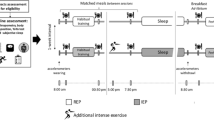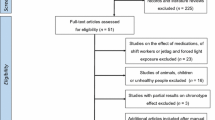Abstract
Purpose
The aim of this study was to compare morning and evening time-trial performance, RPE and mood state of trained swimmers, taking into account chronotype, habitual training time-of-day and PERIOD3 (PER3) variable number tandem repeat genotype.
Methods
Twenty-six swimmers (18 males, age: 32.6 ± 5.7 years) swam 200 m time trials (TT) at 06h30 and 18h30 in a randomised order.
Results
There was no difference between morning and evening performance when the swimmers were considered as a single group (06h30: 158.8 ± 22.7 s, 18h30: 158.5 ± 22.0 s, p = 0.611). However, grouping swimmers by chronotype and habitual training time-of-day allowed us to detect significant diurnal variation in performance, such that morning-type swimmers and those who habitually train in the morning were faster in the 06h30 TT (p = 0.036 and p = 0.011, respectively). This was accompanied by lower ratings of perceived exertion (RPE) scores post-warm-up, higher vigour and lower fatigues scores prior to the 06h30 TT in morning-type swimmers or those who trained in the morning. Similarly, neither types and those who trained in the evenings had lower fatigue and higher vigour prior to the 18h30 TT.
Conclusions
It appears that both chronotype and habitual training time-of-day need to be considered when assessing diurnal variation in performance. From a practical point of view, athletes and coaches should be aware of the potentially powerful effect of training time on shifting time-of-day variation in performance.




Similar content being viewed by others
Abbreviations
- AM:
-
Habitual morning training group
- ANOVA:
-
Analysis of variance
- DNA:
-
Deoxyribonucleic acid
- HÖ:
-
Horne-Östberg
- MT:
-
Morning type
- NT:
-
Neither type
- PER3 :
-
Period3 gene
- PM:
-
Habitual evening training group
- POMS:
-
Profile of mood states
- RPE:
-
Rating of perceived exertion
- TMD:
-
Total mood disturbance
- TT:
-
Time-trial
- VNTR:
-
Variable number tandem repeat
- 4/4:
-
Homozygous for the PERIOD3 4-repeat allele
- 4/5:
-
Heterozygous for the PERIOD3 4- and 5-repeats
- 5/5:
-
Homozygous for the PERIOD3 5-repeat allele
References
Archer SN, Robilliard DL, Skene DJ et al (2003) A length polymorphism in the circadian clock gene Per3 is linked to delayed sleep phase syndrome and extreme diurnal preference. Sleep 26:413–415
Archer SN, Viola AU, Kyriakopoulou V et al (2008) Inter-individual differences in habitual sleep timing and entrained phase of endogenous circadian rhythms of BMAL1, PER2 and PER3 mRNA in human leukocytes. Sleep 31:608–617
Archer SN, Carpen JD, Gibson M et al (2010) Polymorphism in the PER3 promoter associates with diurnal preference and delayed sleep phase disorder. Sleep 33:695–701
Atkinson G, Todd C, Reilly T, Waterhouse J (2005) Diurnal variation in cycling performance: influence of warm-up. J Sport Sci 23:321–329
Baehr EK, Revelle W, Eastman CI (2000) Individual differences in the phase and amplitude of the human circadian temperature rhythm: with an emphasis on morningness-eveningness. J Sleep Res 9:117–127
Baxter C, Reilly T (1983) Influence of time of day on all-out swimming. Br J Sports Med 17:122–127
Bessot N, Moussay S, Gauthier A et al (2006) Effect of pedal rate on diurnal variations in cardiorespiratory variables. Chronobiol Int 23:877–887
Borg G (1998) Borg’s perceived exertion and pain scales. Human Kinetics, Champaign
Brown FM, Neft EE, LaJambe CM (2008) Collegiate rowing crew performance varies by morningness-eveningness. J Strength Cond Res 22:1894–1900
Burgoon PW, Holland GJ, Loy SF, Vincent WJ (1992) A comparison of morning and evening “types” during maximum exercise. J Appl Sport Sci Res 6:115–119
Cappaert TA (1999) Review: time of day effect on athletic performance: an update. J Strength Cond Res 13:412–421
Chtourou H, Souissi N (2012) The effect of training at a specific time of day: a review. J Strength Cond Res 26:1984–2005
Chtourou H, Chaouachi A, Driss T et al (2012a) The effect of training at the same time of day and tapering period on the diurnal variation of short exercise performances. J Strength Cond Res 26:697–708
Chtourou H, Driss T, Souissi S et al (2012b) The effect of strength training at the same time of the day on the diurnal fluctuations of muscular anaerobic performances. J Strength Cond Res 26:217–225
Dalton B, McNaughton L, Davoren B (1997) Circadian rhythms have no effect on cycling performance. Int J Sports Med 18:538–542
Deschenes MR, Sharma JV, Brittingham KT et al (1998) Chronobiological effects on exercise performance and selected physiological responses. Eur J Appl Physiol Occup Physiol 77:249–256
Deschodt VJ, Arsac LM (2004) Morning vs. evening maximal cycle power and technical swimming ability. J Strength Cond Res 18:149–154
Dimitriou L, Sharp NCC, Doherty M (2002) Circadian effects on the acute responses of salivary cortisol and IgA in well trained swimmers. Br J Sports Med 36:260–264
Drust B, Waterhouse J, Atkinson G et al (2005) Circadian rhythms in sports performance—an update. Chronobiol Int 22:21–44
Duffy JF, Dijk DJ, Hall EF, Czeisler CA (1999) Relationship of endogenous circadian melatonin and temperature rhythms to self-reported preference for morning or evening activity in young and older people. J Investig Med 47:141–150
Hill DW, Cureton KJ, Collins MA, Grisham SC (1988) Diurnal variations in responses to exercise of “morning types” and “evening types”. J Sports Med Phys Fit 28:213–219
Horne JA, Östberg O (1976) A self-assessment questionnaire to determine morningness-eveningness in human circadian rhythms. Int J Chronobiol 4:97–110
Kerkhof GA (1998) The 24-hour variation of mood differs between morning- and evening-type individuals. Percept Mot Skills 86:264–266
Kline CE, Durstine JL, Davis JM et al (2007) Circadian variation in swim performance. J Appl Physiol 102:641–649
Kunorozva L, Stephenson KJ, Rae DE, Roden LC (2012) Chronotype and PERIOD3 variable number tandem repeat polymorphism in individual sports athletes. Chronobiol Int 29:1004–1010
Kunorozva L, Roden LC, Rae DE (2014) Perception of effort in morning-type cyclists is lower when exercising in the morning. J Sport Sci 32:917–925. doi:10.1080/02640414.2013.873139
Lastella M, Roach GD, Hurem DC, Sargent C (2010) Does chronotype affect elite athletes’ capacity to cope with the training demands of elite triathlon? In: Sargent C, Darwent D, Roach GD (eds) Living in a 24/7 world: The impact of circadian disruption on sleep. Australasian Chronobiology Society Press, Adelaide, pp 25–28
Lucassen EA, Zhao X, Rother KI et al (2013) Evening chronotype is associated with changes in bating Behavior, more sleep apnea, and increased stress hormones in short sleeping obese individuals. PLoS One 8:e56519
Martin L, Nevill AM, Thompson KG (2007) Diurnal variation in swim performance remains, irrespective of training once or twice daily. Int J Sports Physiol Perform 2:192–200
McNair D, Lorr M, Droppleman L (1971) Manual for the profile of mood states. Educational and Industrial Testing Service, San Diego
Natale V, Cicogna PC (2002) Morningness-eveningness dimension: is it really a continuum? Pers Individ Dif 32:809–816
Pallarés JG, López-Samanes Á, Moreno J (2014) Circadian rhythm effects on neuromuscular and sprint swimming performance. Biol Rhythm Res 45:51–60
Parsons MJ, Lester KJ, Barclay NL et al (2014) Polymorphisms in the circadian expressed genes PER3 and ARNTL2 are associated with diurnal preference and GNβ3 with sleep measures. J Sleep Res (Epub ahead of print)
Racinais S, Connes P, Bishop D et al (2005) Morning versus evening power output and repeated-sprint ability. Chronobiol Int 22:1029–1039
Randler C (2008) Morningness-eveningness comparison in adolescents from different countries around the world. Chronobiol Int 25:1017–1028
Reilly T, Garrett R (1998) Investigation of diurnal variation in sustained exercise performance. Ergonomics 41:1085–1094
Reilly T, Atkinson G, Edwards B et al (2007) Diurnal variation in temperature, mental and physical performance, and tasks specifically related to football (soccer). Chronobiol Int 24:507–519
Roenneberg T, Kuehnle T, Juda M et al (2007) Epidemiology of the human circadian clock. Sleep Med Rev 11:429–438
Souissi N, Driss T, Chamari K et al (2010) Diurnal variation in wingate test performances: influence of active warm-up. Chronobiol Int
Tamm AS, Lagerquist O, Ley AL, Collins DF (2009) Chronotype influences diurnal variations in the excitability of the human motor cortex and the ability to generate torque during a maximum voluntary contraction. J Biol Rhythms 24:211–224
Winget C, DeRoshia C, Holley D (1985) Circadian rhythms and athletic performance. Med Sci Sport Exerc 17:498–516
Acknowledgments
We are grateful to the swimmers for their commitment to this study. KS received the Innovation Masters Scholarship from the National Research Foundation of South Africa, as well as a bursary from the University of Cape Town’s Research Committee. LR received grants from the National Research Foundation of South Africa and the University of Cape Town’s Research Committee. DR received an internal interim grant from the University of Cape Town and DR’s research unit receives funding from Discovery Vitality and the South African Medical Research Council.
Conflict of interest
The authors declare no conflict of interest.
Author information
Authors and Affiliations
Corresponding author
Additional information
Communicated by Dick F. Stegeman.
Rights and permissions
About this article
Cite this article
Rae, D.E., Stephenson, K.J. & Roden, L.C. Factors to consider when assessing diurnal variation in sports performance: the influence of chronotype and habitual training time-of-day. Eur J Appl Physiol 115, 1339–1349 (2015). https://doi.org/10.1007/s00421-015-3109-9
Received:
Accepted:
Published:
Issue Date:
DOI: https://doi.org/10.1007/s00421-015-3109-9




